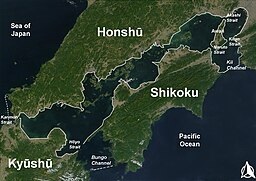 Seto
Sea Seto
Sea
The Seto Inland Sea (瀬戸内海, Seto Naikai), sometimes shortened
to the Inland Sea, is the body of water separating Honshu,
Shikoku, and Kyushu, three of the four main islands of
Japan.
Graphic - The map shows the
boundaries of the Seto Sea.
Click for a larger map
It serves as a waterway connecting the Pacific Ocean
to the Sea of Japan. It connects to Osaka Bay and provides a
sea transport link to industrial centers in the Kansai
region, including Osaka and Kobe. Before the construction of
the San'yō Main Line, it was the main transportation link
between Kansai and Kyūshū.
The prefectures of Okayama, Hiroshima, Yamaguchi, Fukuoka,
Ōita, Tokushima, Kagawa, Ehime, Hyōgo, Wakayama, and Osaka
all have coastlines on the Seto Sea.
The Setouchi region encompasses the sea and surrounding
coastal areas. The region is known for its moderate climate,
with a stable year-round temperature and relatively low
rainfall levels. The sea experiences periodic red tides
caused by dense groupings of certain phytoplankton that
result in the death of large numbers of fish. Since the
1980s, the sea's northern and southern shores have been
connected by the three routes of the Honshū–Shikoku Bridge
Project, including the Great Seto Bridge, which serves both
railroad and automobile traffic.
The coastal region is also called Setouchi, but this is not
the origin of the name Seto Inland Sea; Seto Inland Sea
actually means "the inland sea of Seto."
The Seto Sea stretches 450 km from east to west, 15-55 km
from north to south, with an average depth of about 38 m and
a maximum depth of about 105 m in the Hoyo Strait and Naruto
Straits. The Seto Inland Sea is an inland sea that is known
for its diverse ecosystems and numerous islands. It is a
scenic spot that has been highly praised by many Westerners
and is now designated as part of the Seto Inland Sea
National Park.
Since ancient times, it flourished as a major shipping route
connecting the Kinai region and Kyushu in western Japan. |
|
|
|
|
|
Extent
The area of the Seto Sea is well defined with the simple
explanation of the boundaries being the area within the Kanmon Strait,
the Bungo Channel, and the Kii Channel.
The Seto Inland Sea is made up of several sea areas.
Each of the Seto Inland Sea areas has a separate name in
Japanese. For example, Iyo-nada (伊予灘) refers to the strait
between Ehime, Yamaguchi, and Ōita prefectures in the
western portion of the sea; Aki-nada (安芸灘) is the open
expanse west of the Geiyo Islands, near Hiroshima
prefecture; and Suō-nada (周防灘) refers to the expanse between
Yamaguchi prefecture and Suō-Ōshima. These areas are
sometimes styled Iyonada, Akinada, and Suonada. There are
also many straits located between the major islands, as well
as a number of smaller ones that pass between islands or
connect the Seto Inland Sea to other seas or the Pacific.
Almost 3,000 islands are located in the Seto Inland Sea. The
largest island is Awaji-shima, and the second largest is
Shōdo-shima. Many of the smaller islands are uninhabited.
Under the Law on the Territorial Sea and Contiguous Zone,
the Seto Sea is divided into the following 10 sea areas,
beginning from the eastern side: |
- Kii Channel
- The Kii Channel is an area of sea surrounded by
Wakayama Prefecture, Tokushima Prefecture, and Awaji
Island in Hyogo Prefecture.
- Osaka Bay
- Osaka Bay is a bay located between the Osaka Plain and
Awaji Island.
- Harima Sea
- The Harima Nada Sea is an area in the eastern part of
the Seto Inland Sea.
- Bisan Seto
- Bisan Seto is the name of the area of the Seto
Inland Sea between Okayama Prefecture and Kagawa
Prefecture.
- Bingonada
- Bingo Nada is an area of water in the central part
of the Seto Inland Sea.
- Hiuchinada
- Hiuchi Nada is one of the sea areas located in the
central part of the Seto Inland Sea.
- Akinada
- Akinada is an area of sea located in the western
part of the Seto Inland Sea.
- Hiroshima Bay
- Hiroshima Bay is a bay in the Seto Inland Sea located
on the southern coast of Hiroshima Prefecture.
- Iyonada
- Iyonada is an area in the western part of the Seto
Inland Sea.
- Suonada
- The Suo- Nada Sea is an area of sea located at the
northwestern end of the Seto Inland Sea.
|
|
The Seto Inland Sea Environment Conservation Special
Measures Act adds the following sea areas to the 10
mentioned above, making a total of 12 divisions. |
- Northern
Bungo Channel - The Bungo Channel is a channel
located between Oita Prefecture in Kyushu and Ehime
Prefecture in Shikoku.
- Hibiki
- Hibikinada is an area of sea that stretches
northwest of the Kanmon Straits, and is adjacent to the
Sea of Japan to the northeast and the Genkai Sea to
the west.
|
|
|
|
Insert Seto Sea Picture |
Geography
The Seto Sea stretches 450 km (280 mi) lfrom east to west,
15-55 km from north to south (10 to 34 mi), has a total
coastline of 7,230 km, an area of 23,203 km2, an average
depth of 38.0 m, and a volume of 881.5 billion m3. It is an
archipelago with 727 islands with a circumference of 0.1 km
or more. If smaller islands are included, the number is said
to be several thousand, but the classification is unclear
because it depends on the criteria for an "island."
In most places, the water is relatively shallow. The average
depth, as previously stated, is 38.0 m (125 ft); the greatest depth is 105 m (344
ft). The general trend is that it gets shallower the further
east you go. It has a complex structure with wide areas
called "nada" or "bays" connected by narrow waterways called
"seto" or "straits." The waterways have had their bottom
eroded by powerful tidal currents . The deepest part is
thought to be about 195m at Hoyo Strait ( Hayasui Seto ) and
about 200m at Naruto Strait.
Hydrologically, the Seto Inland Sea is not a true inland sea,
being neither an
epeiric body of water like Hudson Bay nor
an isolated endoheic basin like the Caspian Sea. Rather, it
is actually a marginal sea: a division of a wider ocean (in
this case the Pacific) which is partially enclosed by
islands, archipelagos, or peninsulas (here, the Japanese
Home Islands), adjacent to or widely open to the open ocean
at the surface. The Naruto Strait connects the eastern part
of the Seto Inland Sea to the Kii Channel, which in turn
connects to the Pacific. The western part of the Seto Inland
Sea connects to the Sea of Japan through the Kanmon Straits
and to the Pacific through the Bungo Channel. |
|
|
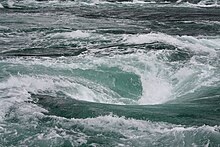 Strong
Currents Strong
Currents
The Seto Inland Sea is known for its large tidal range.
Graphic - Naruto whirlpools
as seen from a tourist boat.
This becomes more pronounced the further in the sea you go, with the tidal
range reaching over 2m around the innermost Hiuchi Nada Sea.
Because of this, the tidal currents in the Seto Inland Sea
are extremely strong, and in some places they flow like
rivers. These powerful currents are what create the Naruto
whirlpools. It is also thought that these powerful currents
constantly stir up nutrients from the seabed, promoting the
growth of phytoplankton. In other words, one of the reasons
why the Seto Inland Sea is such a diverse fishing ground is
the large tidal range. |
|
|
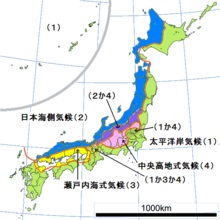 Climate Climate
The Seto Inland Sea climate is one of the climate divisions
of Japan. It is also called the Seto Inland Sea climate,
Seto Inland Sea type climate, or Setouchi climate. It is
mainly found in the Setouchi region.
Graphic - The yellow on the
map is the area affected by the Seto Inland Sea climate.
Click for a larger graphic
The Setouchi region is known for its moderate climate, with
a stable year-round temperature and relatively low rainfall
levels.
The seasonal winds are suppressed by the Shikoku Mountains
in Summer and the Chugoku Mountains in Winter, making the
climate more moderate throughout the year, with many sunny
days and little rain. Snowfall occurs about once or twice a
year, but heavy snowfall is rare except in mountainous
areas.
Click for detailed climate information.... |
|
|
Major Islands
There are around 3,000 islands, large and small, in the Seto
Inland Sea, including uninhabited islands and tiny islands
with a circumference of just a few meters.
The main islands of the Seto Inland Sea are shown below. |
- Eastern
- Awaji Island, Shōdo
Island, Ieshima Islands, Naoshima Islands, Shiwaku
Islands, Yumeshima
- Central
- Omishima, Innoshima, Itsukushima (popularly
known as Miyajima), Hinase Islands, Kasaoka Islands, Osakikamijima, Ikuchijima,
Mukaijima, Hoboro Island
- Western
- Yashiro Island (Suo-Oshima), Uwakai
Islands, Hashira-jima Islands, Kurahashi Island,
Nomi Island (integrated with Etajima), Itsukushima.
|
Major Inflowing Rivers
The inflowing rivers with a drainage area of 1,000 km2 or
more are as follows: |
- Kii Channel: Kino River, Yoshino River
- Osaka Bay: Yodo River, Yamato River
- Harima Sea: Kakogawa
- Bisan Seto: Yoshii River, Asahi River, Takahashi River
- Hiroshima Bay: Ota River
- Iyonada: Hijikawa River, Ono River
|
|
Major Coastal Cities |
- Okayama
Prefecture: Bizen City, Setouchi City, Okayama
City, Tamano City, Kurashiki City, Kasaoka City, Asakuchi City
- Hiroshima
Prefecture:
Fukuyama City, Onomichi City, Mihara City, Takehara City, Higashihiroshima City, Kure City, Hiroshima City, Hatsukaichi City, Otake City
- Yamaguchi Prefecture:
Iwakuni City, Yanai City, Hikari City, Kudamatsu City, Shunan City, Hofu City, Ube City, Sanyo Onoda City, Shimonoseki City
- Fukuoka Prefecture:
Kitakyushu City, Yukuhashi City, Buzen City
- Oita Prefecture:
Nakatsu City, Usa City, Bungotakada City, Kunisaki City, Kitsuki City, Beppu City, Oita City
- Tokushima Prefecture:
Naruto City, Tokushima City, Komatsushima City, Anan City
- Kagawa Prefecture:
Kanonji City, Mitoyo City, Marugame City, Sakaide City,
Takamatsu City, Sanuki City, Higashikagawa City
- Ehime Prefecture:
Iyo City, Matsuyama City, Imabari City, Saijo City, Niihama City, Shikokuchuo City
- Hyogo Prefecture:
Amagasaki City, Nishinomiya City, Ashiya City, Kobe City, Akashi City, Kakogawa City, Takasago City, Himeji City,
Tatsuno City, Aioi City, Ako City, Awaji City, Sumoto
City, Minami Awaji City
- Wakayama Prefecture:
Wakayama City, Kainan City, Arita City
- Osaka Prefecture:
Hannan City, Sennan City, Izumisano City, Kaizuka City, Kishiwada City, Izumiotsu City, Takaishi City, Sakai City, Osaka City
|
|
Sea Routes |
- Long-distance ferry routes
- Mitsui O.S.K. Lines Sunflower (Osaka Port - Beppu Port,
Kobe Port - Oita Port)
- Hankyu Ferry (Izumiotsu Port - Shinmoji Port, Kobe Port - Shinmoji Port)
- Prestigious Taiyo Ferry (Osaka Port - Shinmoji Port)
- Medium-distance ferry routes
- Jumbo Ferry (Kobe Port - Shodoshima Sakate Port - Takamatsu
Port)
- Orange Ferry (Osaka Port - Toyo Port, Kobe Port - Niihama
East Port)
- Matsuyama-Kokura Ferry (Matsuyama Port - Kokura Port)
- Inter-island shipping routes
- Shikoku Ferry, Shodoshima Ferry (Takamatsu Port - Shodoshima, Himeji Port - Shodoshima, Okayama Port -
Shodoshima)
- Shodoshima-Teshima Ferry (Uno Port -Teshima - Shodoshima)
- Ryobi Transportation (Shin-Okayama Port - Shodoshima)
- Honshu-Shikoku Route
- Setonaikai Kisen and Ishizaki Kisen (joint operation) - (Hiroshima Port - Kure Port - Matsuyama Port)
- Boyo Ferry (Yanai Port - Matsuyama Port)
|
|
Insert Fauna Picture |
Fauna
Over 500 marine species are known to live in the Seto Inland
Sea. Examples are the ayu, an amphidromous fish, horseshoe
crab, finless porpoise, and great white shark, which has
occasionally attacked people in the Seto Inland Sea. In the
past, whales entered the sea to feed or breed, however
because of whaling and pollution, they are rarely seen. |
|
|
|
Insert History Picture |
History
During the last ice age, the sea level was lower than today.
After the ice age, sea water poured into a basin between the
Chūgoku mountains and Shikoku mountains and formed the Seto
Inland Sea as it is known today. From ancient times, the
Seto Inland Sea served as a main transport line between its
coastal areas, including what is today the Kansai region and
Kyushu. It was also a main transport line between Japan and
other countries, including Korea and China. Even after the
creation of major highways such as the Nankaidō and San'yōdō,
the Seto Inland Sea remained a major transport route. There
are records that some foreign emissaries from China and
Korea sailed on the Seto Inland Sea.
The importance of water traffic gave rise to private navies
in the region. In many documents, these navies were called
suigun (水軍, "water army"), or simply pirates. Sometimes they
were considered to be public enemies, but in most cases they
were granted the right to self-governance as a result of
their strength. During the feudal period, suigun seized
power in most coastal areas. The Kono in Iyo Province (today
Ehime Prefecture) and Kobayakawa (later Mōri) in Aki
Province (today a part of Hiroshima Prefecture) clans were
two of the more famous suigun lords. In the 12th century,
Taira no Kiyomori planned to move the capital from Kyoto to
the coastal village of Fukuhara (today Kobe) to promote
trade between Japan and the Song dynasty of China. This
transfer was unsuccessful, and soon after Kyoto became the
capital again. Later, the Battle of Yashima took place off
the coast of present-day Takamatsu.
In the Edo period, the Seto Inland Sea was one of the
busiest transport lines in Japan. It was a part of a
navigational route around Japan's islands via the Sea of
Japan. Many ships navigated from its coastal areas to the
area along the Sea of Japan. Major ports in the Edo period
were Osaka, Sakai, Shimotsui, Ushimado, and Tomonoura. The
Seto Inland Sea also served many daimyōs in the western area
of Japan as their route to and from Edo, to fulfill their
obligations under sankin-kōtai. Many used ships from Osaka.
Thanks to transport through the Seto Inland Sea, Osaka
became the economic center of Japan. Each han had an office
called Ozakayashiki in Osaka. These Ozakayashiki were among
Japan's earliest forms of banks, facilitating domestic trade
and helping to organize the income of the daimyo, which was
in the form of koku, giant bales of rice.
The Seto Inland Sea was also part of the official
Chosendentsushi route, bringing Korean emissaries to the
shogunate. After the Meiji Restoration, the coastal cities
along the Seto Inland Sea were rapidly industrialized. One
of the headquarters of the Japanese Navy was built in the
town of Kure. Since the Meiji period, development of land
transport has been reducing the importance of the Seto
Inland Sea as a transport line. Remarkable land
transportation innovations include the San'yō Main Railroad
Line in Honshū and the Yosan Main Railroad Line in Shikoku
(both completed before World War II) and three series of
bridges connecting Honshū and Shikoku (completed in the late
20th century). The Seto Inland Sea is still used, however,
by an international cargo transport line and several local
transport lines connecting Honshū with Shikoku and Kyūshū.
Continue reading.... |
|
|
|
|
|
|
Insert Industry Picture |
Industry
Major cities with heavy industrial activity on the coast of
the Seto Inland Sea include Osaka, Kobe, and Hiroshima.
Smaller scale manufacturing and industry can also be found
in Kurashiki, Kure, Fukuyama, and Ube in Honshū, and Sakaide,
Imabari, and Niihama in Shikoku. Major industries include
steel production, vehicle manufacture, ship building,
textiles, and since the 1960s, oil refining and chemical
products. Imabari Shipbuilding, Japan's largest ship
building company, has its headquarters and some of its yards
in Imabari, Ehime Prefecture. Thanks to the moderate climate
and beautiful landscape, fishing, agriculture, and tourism
bring a lot of income to the area as well. |
|
|
|
Insert Transportation Picture |
Transportation
Today the Seto Inland Sea serves its coastal areas mainly
for two purposes: first, international or domestic cargo
transportation, and second, local transportation between
coastal areas and islands on the sea. Major ports are Kobe,
Okayama, Takamatsu, Tokushima, Matsuyama, and Hiroshima.
Historically, the Seto Inland Sea as transport line served
four coastal areas: Kansai, Chūgoku, Shikoku, and eastern
Kyūshū. The Seto Inland Sea provided each of these regions
with local transportation and connected each region to the
others and far areas, including the coastal area of the Sea
of Japan, Korea, and China. After Kobe port was founded in
1868 to serve foreign ships, the Seto Inland Sea became a
major international waterway with connection to the Pacific.
Development of land transportation shifted the travel
between east and west - that is, between Honshū and Kyūshū -
to railroad and road transport. Two coastal railways, San'yō
Main Line in Honshū and Yosan Main Line, were built. Those
railway lines stimulated the local economy and once invoked
a rail mania. Many short railroads were planned to connect a
certain station of those two lines and a local seaport on
the Seto Inland Sea, and some of them were actually built.
The Ministry of Railroads, later the Japanese National
Railways and then Shikoku Railway Company, ran some train
ferry lines between Honshū and Shikoku including the line
between Uno Station (Tamano) and Takamatsu Station
(Takamatsu). When the Great Seto Bridge was finished and
began to serve the two coastal areas, that ferry line was
abolished. |
|
|
|
Insert Bridge Picture From
Wikipedia |
Highways and Bridges
The main islands Honshū and Shikoku are connected by three
series of bridges since the late 1980s. This improves land
transportation between the connected islands. These series
of bridges, collectively known as the Honshū–Shikoku Bridge
Project, are, from east to west, Akashi Kaikyo Bridge, Great
Seto Bridge, and Nishiseto Expressway. |
- Kobe-Awaji-Naruto
Highway - The easternmost highway was built
between 1976 and 1998. It leads from Akashi (Hyōgo
Prefecture) on the Akashi Kaikyo Bridge (the
second-longest suspension bridge in the world) to Awaji
Island, from there via the Ōnaruto Bridge to Ōge-jima (Naruto,
Tokushima Prefecture) beyond the 1.3-kilometer wide
Naruto Strait and finally across the Muya Bridge to
Shikoku.
- Seto Chuo
Highway - The Great Seto Bridge connects Okayama
Prefecture with Kagawa Prefecture since 1988. It
consists of a total of six two-story bridges, whose
lower floors are used by the railway (Japan Railways
Group). The high speed Shinkansen does not go to or on
Shikoku.
- Nishiseto
Highway / Shimanami Highway - This is the first
of three intersections of the Seto Inland Sea.
Construction started in 1975, but was fully completed in
1999. It connects the Nishiseto- Onomichi Highway in
Hiroshima Prefecture with a total of ten bridges and
several smaller islands with Imabari in Ehime
Prefecture. Approximately 100,000 people live on those
islands. The bridges are: Shin Onomichi Bridge,
Innoshima Bridge, Ikuchi Bridge, Tatara Bridge, Ōmishima
Bridge, the two Ōshima bridges and the three Kurushima
Kaikyo bridges. The Kurushima Kaikyō Bridge connects the
island of Ōshima to the main island of Shikoku.
- Other bridges
- The Akinada Tobishima Kaido route connects seven of
the western Geiyo Islands to mainland Honshu near Kure,
Hiroshima.
|
Maritime
Seto Naikai Pilots Area provides compulsory maritime
piloting for vessels over 10,000 tones, it was divided into
sections of Bisanseto and sections of Kurushima, connecting
Kanmon Channel Piloting Area and Osaka Bay Piloting Area. |
|
|
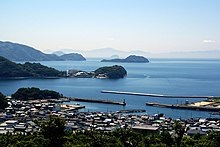 Major Tourist Sites Major Tourist Sites
The coastal area of the Seto Inland Sea is one Japan's major
tourist destinations.
Graphic - The beauty of the
Seto Inland Sea's many islands specifically Suo-Oshima Town,
Yamaguchi Prefecture.
Even before the country opened to foreigners in the middle
of the 19th century, the sea's beauty was praised and
introduced to the Western world by those who visited Japan.
Its coastal area, except for Osaka Prefecture and a part of
Wakayama Prefecture, was appointed to the Setonaikai National
Park (瀬戸内海国立公園, Setonaikai Kokuritsu kōen) on March 16,
1934, as one of the three oldest national parks in Japan. |
|
|
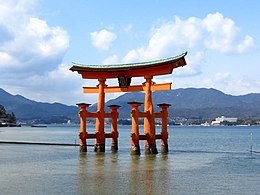 Itsukushima Shrine, on the island of Itsukushima in the city
of Hatsukaichi, is a UNESCO World Heritage Site. Itsukushima Shrine, on the island of Itsukushima in the city
of Hatsukaichi, is a UNESCO World Heritage Site.
Graphic - The torii of
Itsukushima Shrine appears to float in the water.
Shōdoshima,
nicknamed the "island of olives", and the Naruto whirlpools
are two other well-known tourist sites. Neighboring
locations like Kotohira and Okayama are often combined with
the tour of the Setouchi region. Some historic sites,
including Yashima in Takamatsu and Kurashiki, also attract
many visitors. Hiroshima is the neighbor city to Itsukushima
Shrine and another UNESCO World Heritage Site because of
atomic bomb damage in 1945.
The eastern end of the Sea hosts the Setouchi Triennale art
festival, which was inaugurated in 2010. Some events take
place on the island of Naoshima, known colloquially as the
art island, and the home of several permanent museums.
At the far eastern extremity, as the Sea meets the Pacific
Ocean, are the Naruto whirlpools that can be reached by
sight-seeing boats.
In the central area of Seto Inland Sea is Mount Ishizuchi on
Shikoku. It is the highest mountain in western Japan and the
highest mountain on Shikoku.
In the western end of the Sea is Mimosusogawa Park in
Shimonoseki. It commemorates the final stage of the Genpei
war between the feudal Taira clan and Minamoto clan
(1180–1185). |
|
|
|
|
|
|
|
|
|
|